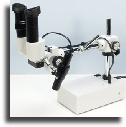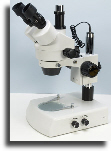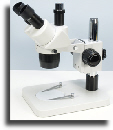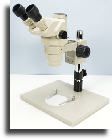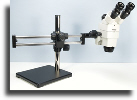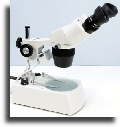BRUNEL MICROSCOPES LTD
Specialists in their Field
Stereomicroscopes Basics
A common error for the novice microscopist is to use too high a magnification. The more a microscope magnifies an object, the smaller the part of it that can be seen at any one time. The smaller this area the more difficult it is to decide exactly what the object is. For example a spiders leg magnified x 1000 shows only a very uninteresting tiny area of brown or black colouring depending on the exact piece which is being looked at. In many ways this is rather like trying to identify the White Cliffs of Dover from 2 inches away!
Only the lowest magnification needed to see the detail required should be used in microscopy. A spiders leg yields far more information magnified by as little as say x 20. Remember individual human blood cells can be seen at x 500, and the only items needing x 1000 are bacteria and some of the very small fungal spores.
There are basically two types of microscope available, the low power stereomicroscope (which produces a 3D image of a whole object), and the high power or compound which can magnify up to x1500 and is used for slide preparations.
The Low Power Stereomicroscope
This type of microscope has a much greater depth of focus than a high power microscope, allowing much more of the object depth to be in focus at the same time. Stereomicroscopes utilise this phenomenon using a double lens system consisting of two eyepieces each with their own objective. In the microscope these two lens systems are at a slight angle to one another which produces a 3D effect.
Stereomicroscopes are used for looking at whole objects without the need for slide preparation and are ideal for those with a general interest in the smaller forms of nature or specifically for examining insects, flowers, coins and metal objects, etc.
Stereomicroscopes are an ideal introduction to microscopy for children who are able to look at any object instantly, and at a relatively low magnification which allows them to make sense of what they see. All too often children are put off microscopes by being given a toy high powered microscope which requires slide preparation, and often gives a very poor result because of the plastic lenses that they use. This sort of microscope cannot be used to look at whole objects which is exactly what the budding young scientist wants to do.
Stereomicroscopes have many and varied uses in commercial quality control, and are available in long arm - allows the examination of large areas using a heavy base stand, zoom - gives variable magnifications within a range, and trinocular - allows a camera or CCTV unit to be mounted on the microscope at the same time.
Stereos must not be confused with binocular high powered microscopes. Binocular high powered microscopes use only one objective at a time, do not give a 3D image and are used for looking at slide preparations at high power. Stereos have two objectives one for each eyetube, are not used for slides and give a 3D image at low power - typically x 10 to x 40 magnification.
Only the lowest magnification needed to see the detail required should be used in microscopy. A spiders leg yields far more information magnified by as little as say x 20. Remember individual human blood cells can be seen at x 500, and the only items needing x 1000 are bacteria and some of the very small fungal spores.
There are basically two types of microscope available, the low power stereomicroscope (which produces a 3D image of a whole object), and the high power or compound which can magnify up to x1500 and is used for slide preparations.
The Low Power Stereomicroscope
This type of microscope has a much greater depth of focus than a high power microscope, allowing much more of the object depth to be in focus at the same time. Stereomicroscopes utilise this phenomenon using a double lens system consisting of two eyepieces each with their own objective. In the microscope these two lens systems are at a slight angle to one another which produces a 3D effect.
Stereomicroscopes are used for looking at whole objects without the need for slide preparation and are ideal for those with a general interest in the smaller forms of nature or specifically for examining insects, flowers, coins and metal objects, etc.
Stereomicroscopes are an ideal introduction to microscopy for children who are able to look at any object instantly, and at a relatively low magnification which allows them to make sense of what they see. All too often children are put off microscopes by being given a toy high powered microscope which requires slide preparation, and often gives a very poor result because of the plastic lenses that they use. This sort of microscope cannot be used to look at whole objects which is exactly what the budding young scientist wants to do.
Stereomicroscopes have many and varied uses in commercial quality control, and are available in long arm -
Stereos must not be confused with binocular high powered microscopes. Binocular high powered microscopes use only one objective at a time, do not give a 3D image and are used for looking at slide preparations at high power. Stereos have two objectives one for each eyetube, are not used for slides and give a 3D image at low power -
